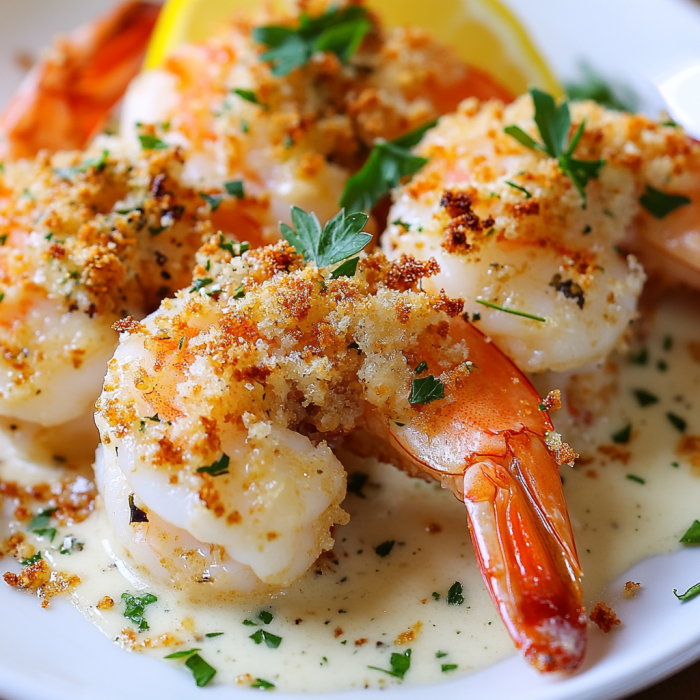Baked stuffed shrimp is a beloved seafood dish that combines the delicate flavors of shrimp with a savory crabmeat stuffing, creating a harmonious blend that is both elegant and comforting. This classic recipe is a staple in many households, particularly in the New England region, where seafood is celebrated for its freshness and abundance. The dish is not only cherished for its taste but also for the warm memories it evokes, often associated with family gatherings and special occasions.
The Rich History of Baked Stuffed Shrimp
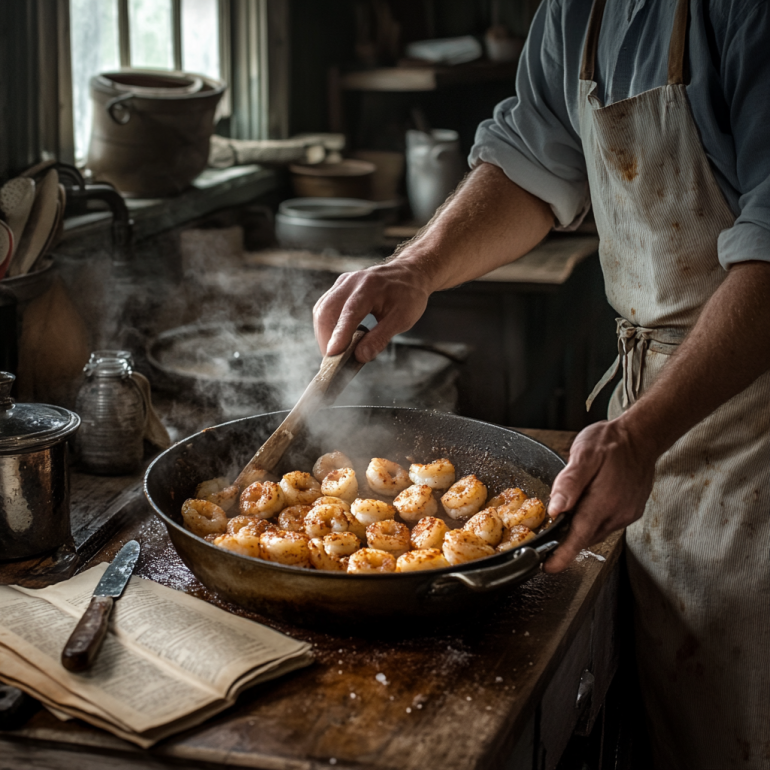
The history of baked stuffed shrimp is deeply rooted in the culinary traditions of New England, where the dish originated as a way to showcase the region’s abundant seafood. Over time, the recipe has evolved, with each family adding their unique twist while preserving the core ingredients that make it special. The use of Ritz crackers in the stuffing is a hallmark of the classic preparation, providing a delightful crunch that complements the tender shrimp. For more insights into New England cuisine, you can explore resources like Yankee Magazine.
Origins and Evolution
Baked stuffed shrimp emerged in the coastal towns of New England, where fresh seafood was plentiful. The dish was initially prepared in homes and small local eateries, using readily available ingredients like shrimp, crabmeat, and crackers. The combination of these ingredients created a unique texture and flavor profile that quickly gained popularity.
As the dish spread across the region, it became a staple in many seafood restaurants. Chefs began experimenting with different seasonings and ingredients to enhance the flavors further. Some added a touch of sherry or white wine to the stuffing, while others incorporated herbs like parsley and tarragon. These variations contributed to the rich tapestry of flavors that define New England cuisine.
Cultural Significance
Baked stuffed shrimp holds a special place in the cultural fabric of New England. It is often served during holidays and family gatherings, symbolizing togetherness and tradition. The dish is more than just a meal; it is a shared experience that brings people together, evoking nostalgia and creating new memories.
Key Ingredients for Baked Stuffed Shrimp
To create the perfect baked stuffed shrimp, you need a blend of fresh seafood and complementary ingredients that enhance the dish’s flavors and textures.
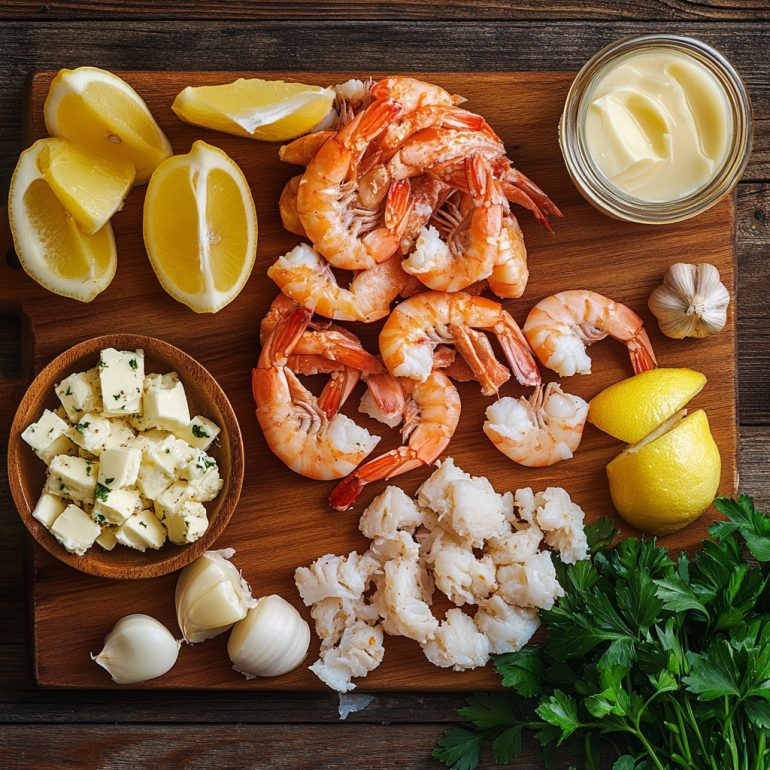
Shrimp
- Size and Type: The star of the dish is typically jumbo or extra-large shrimp. These sizes provide a substantial base for the stuffing and are easier to handle during preparation. Ensure the shrimp are fresh or properly thawed if frozen.
- Preparation: Cleaning and deveining the shrimp is crucial. This step removes any unwanted parts and prepares the shrimp for stuffing. To butterfly the shrimp, make a deep cut along the inner curve, almost cutting through, and gently press open to form a pocket.
Crabmeat
- Quality and Alternatives: Crabmeat adds a rich seafood flavor to the stuffing. You can use lump crabmeat for a more luxurious texture or imitation crab for a budget-friendly option. The crabmeat should be well-drained to avoid excess moisture in the stuffing.
- Flavor Enhancement: Mixing the crabmeat with herbs, garlic, and lemon juice enhances its natural flavors and creates a cohesive stuffing mixture.
Crackers
- Ritz Crackers: Traditionally, Ritz crackers are used for their buttery flavor and crispy texture. They provide a delightful crunch that complements the tender shrimp. Crush the crackers finely to ensure they integrate well with the other ingredients.
- Alternatives: If you prefer a different texture or flavor, you can use panko breadcrumbs or other buttery crackers. Some recipes even use crushed potato chips for a unique twist.
Seasonings and Herbs
- Garlic and Parsley: These are essential for adding depth and freshness to the stuffing. Minced garlic provides a savory base, while chopped parsley adds a pop of color and a mild, slightly peppery flavor.
- Lemon Juice and Zest: Lemon juice brightens the flavors and adds a tangy note, while the zest provides a subtle, aromatic undertone. Together, they enhance the seafood flavors and balance the richness of the butter and crackers.
- Additional Flavors: Some recipes include a touch of sherry or white wine for added depth. These ingredients can be added to the stuffing mixture or used to deglaze the pan when sautéing aromatics like garlic and onions.
Preparation Steps for Baked Stuffed Shrimp
Preparing baked stuffed shrimp involves several steps, each contributing to the final dish’s success. Follow these guidelines to ensure a delicious and visually appealing result.
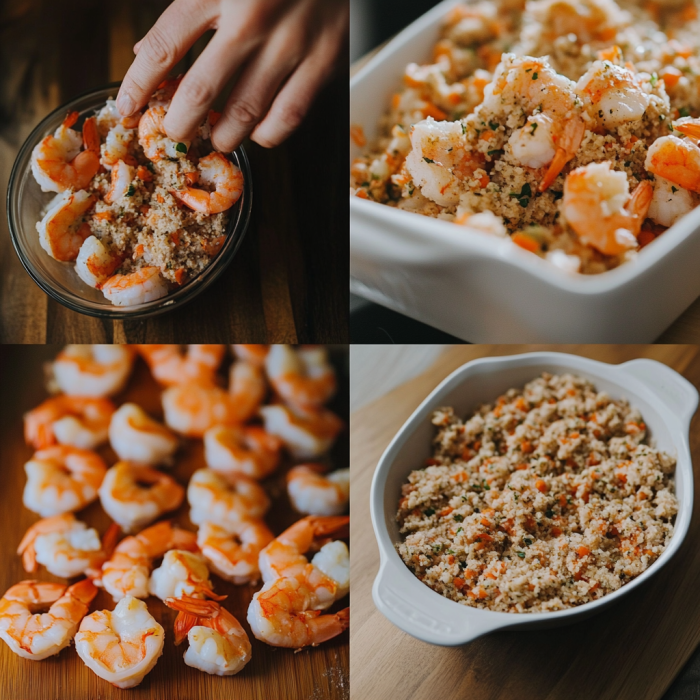
Cleaning and Deveining Shrimp
- Importance: This step is crucial for removing any unwanted parts, such as the vein and shell, which can affect the texture and presentation of the dish.
- Technique: Hold the shrimp firmly and use a sharp knife to make a shallow cut along the back. Remove the vein and any remaining shell fragments. Rinse the shrimp under cold water and pat them dry to remove excess moisture.
Making the Stuffing
- Ingredient Combination: In a bowl, combine the crabmeat, crushed crackers, melted butter, minced garlic, chopped parsley, lemon juice, and zest. Mix well to create a cohesive stuffing mixture. The consistency should be moist but not overly wet.
- Seasoning: Taste the stuffing and adjust the seasoning with salt and pepper as needed. You can also add a pinch of cayenne pepper for a slight kick or paprika for color and a mild, sweet flavor.
Butterflying Shrimp
- Technique: To butterfly the shrimp, make a deep cut along the inner curve, almost cutting through, and gently press open to form a pocket. This technique creates a larger surface area for the stuffing and makes the shrimp easier to handle.
- Presentation: Butterflying the shrimp also enhances the dish’s visual appeal, as the shrimp will have a more elegant and uniform shape when stuffed and baked.
Assembling the Dish
- Stuffing the Shrimp: Place a generous amount of stuffing on each butterflied shrimp, pressing it gently but firmly into the pocket. Ensure the stuffing is evenly distributed and securely attached to the shrimp.
- Arranging in the Baking Dish: Place the stuffed shrimp in a baking dish, with the stuffed side facing up. Arrange them in a single layer, leaving some space between each shrimp to allow for even cooking and browning.
Cooking Techniques for Baked Stuffed Shrimp
Cooking baked stuffed shrimp requires attention to detail to achieve the perfect texture and flavor. Follow these techniques to ensure a successful outcome.
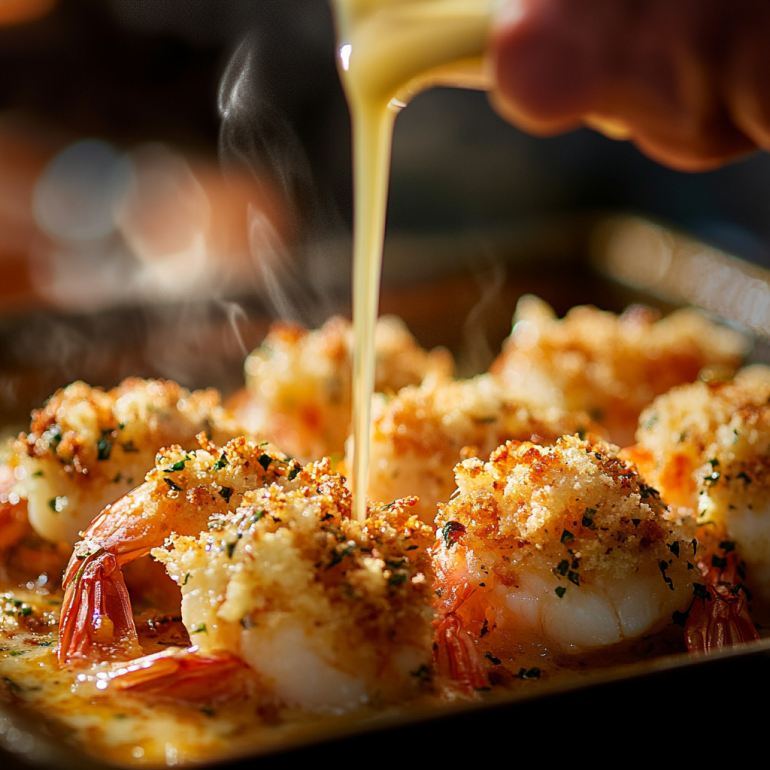
Baking Tips
- Oven Temperature: Preheat your oven to 375°F (190°C). This temperature ensures that the shrimp cook gently and evenly, preventing them from becoming tough or rubbery.
- Baking Time: Bake the stuffed shrimp for about 15-20 minutes, or until the shrimp are opaque and the stuffing is golden brown. The exact time may vary depending on the size of the shrimp and your oven’s calibration.
- Checking Doneness: The shrimp are done when they turn opaque and slightly pink. Avoid overcooking, as this can lead to a tough and dry texture. You can use a meat thermometer to check the internal temperature, which should reach 145°F (63°C).
Keeping Shrimp Moist
- Adding Water: Add a small amount of water to the baking dish to keep the shrimp moist during baking. This prevents them from drying out and ensures a tender texture. You can also cover the dish with foil for the first half of the cooking time to trap steam and retain moisture.
- Basting: Brush the shrimp with melted butter or a mixture of butter and lemon juice halfway through cooking. This adds moisture and enhances the flavors, resulting in a more succulent dish.
Alternative Cooking Methods
- Broiling: For a crispier top, broil the shrimp for the last 1-2 minutes of cooking. Keep a close eye on them to prevent burning. Broiling caramelizes the surface and adds a slight char that enhances the flavors.
- Grilling: Grilling baked stuffed shrimp adds a smoky flavor and creates attractive grill marks. Preheat your grill to medium-high heat and cook the shrimp for about 5-7 minutes on each side, or until they are opaque and the stuffing is golden brown.
- Air-Frying: Air-frying is a healthier alternative to deep-frying that still achieves a crispy exterior. Preheat your air fryer to 375°F (190°C) and cook the shrimp for about 8-10 minutes, or until they are golden brown and crispy. Shake the basket halfway through cooking to ensure even browning.
Serving Suggestions for Baked Stuffed Shrimp
Baked stuffed shrimp is a versatile dish that pairs well with various side dishes and presentation styles. Consider the following serving suggestions to complement your meal.
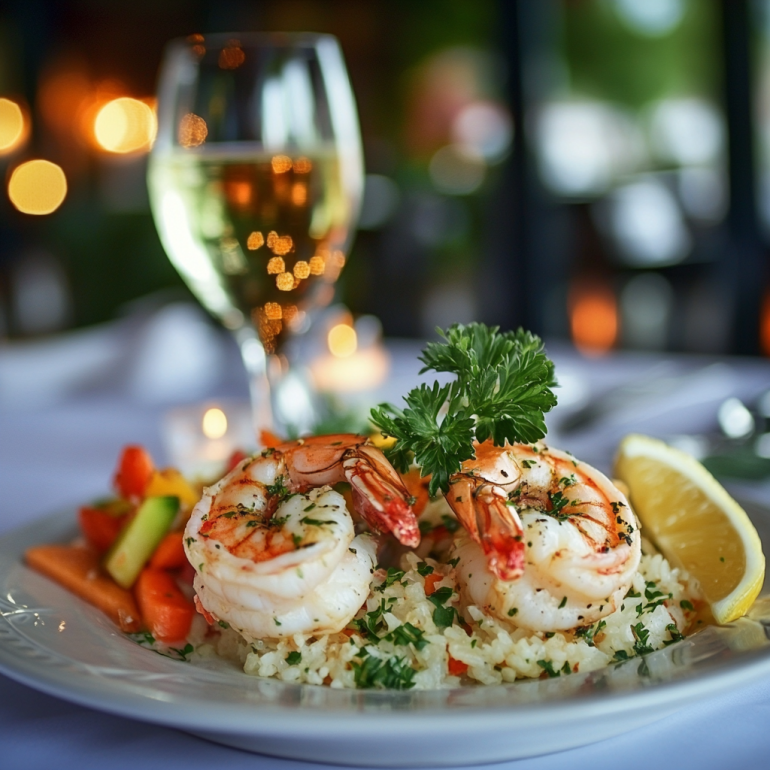
Side Dishes
- Classic Pairings: Serve baked stuffed shrimp with a side of rice pilaf, a garden salad, or baked potato for a classic and elegant presentation. These sides complement the rich seafood flavors and provide a balanced meal.
- Modern Twists: For a contemporary twist, consider serving the shrimp with roasted vegetables, quinoa, or a light pasta salad. These options add color, texture, and nutritional value to the dish.
- Comfort Food: Pair the shrimp with creamy mashed potatoes, macaroni and cheese, or garlic bread for a hearty and satisfying meal that evokes comfort and warmth.
Presentation Tips
- Plating: Arrange the stuffed shrimp on a platter, garnished with fresh parsley and lemon wedges. This presentation adds visual appeal and allows guests to appreciate the dish’s elegance.
- Garnishes and Sauces: Offer a side of melted butter or a tangy cocktail sauce for dipping. You can also drizzle the shrimp with a lemon-herb butter sauce or a creamy aioli for added flavor and richness.
- Individual Servings: For a more intimate presentation, serve the shrimp in individual ramekins or small baking dishes. This approach allows each guest to enjoy their own portion and adds a personal touch to the meal.
Nutritional Information for Baked Stuffed Shrimp
Baked stuffed shrimp is a rich and indulgent dish with a calorie count that varies based on the ingredients used. Understanding its nutritional profile can help you make informed decisions about portion sizes and accompaniments. For detailed nutritional information, you can refer to resources like the National Institutes of Health.
Calorie and Macronutrient Breakdown
- Calories: The calorie count for baked stuffed shrimp can range from 300 to 500 calories per serving, depending on the size of the shrimp and the amount of stuffing used. The primary contributors to the calorie count are the shrimp, crabmeat, butter, and crackers.
- Protein: Shrimp and crabmeat are excellent sources of lean protein, providing essential amino acids for muscle repair and growth. A serving of baked stuffed shrimp can contain between 20 and 30 grams of protein.
- Fat: The butter and crackers contribute to the fat content, which can range from 15 to 25 grams per serving. To reduce the fat content, you can use less butter or opt for a lighter spread.
- Carbohydrates: The crackers and any added breadcrumbs contribute to the carbohydrate content, which can range from 10 to 20 grams per serving. To lower the carb count, you can use fewer crackers or opt for a low-carb alternative.
Vitamins and Minerals
- Vitamin B12: Shrimp and crabmeat are rich in vitamin B12, which is essential for nerve function and blood cell formation. A serving of baked stuffed shrimp can provide a significant portion of your daily B12 requirements.
- Selenium: Seafood is a good source of selenium, a mineral that supports thyroid function and acts as an antioxidant. Baked stuffed shrimp can contribute to your daily selenium intake.
- Omega-3 Fatty Acids: While not as high in omega-3s as fatty fish like salmon, shrimp and crabmeat still provide some of these essential fats, which support heart health and reduce inflammation.
Allergens and Dietary Considerations
- Shellfish: Shrimp and crabmeat are common allergens, so be mindful of any dietary restrictions or allergies when serving this dish.
- Gluten: The crackers used in the stuffing may contain gluten. To make the dish gluten-free, use gluten-free crackers or breadcrumbs.
- Dairy: The butter in the stuffing contributes to the dairy content. To make the dish dairy-free, use a plant-based butter alternative or olive oil.
Variations and Customizations for Baked Stuffed Shrimp
Baked stuffed shrimp is a versatile dish that can be customized to suit various dietary preferences and regional tastes. Explore the following variations to create a unique and personalized meal.
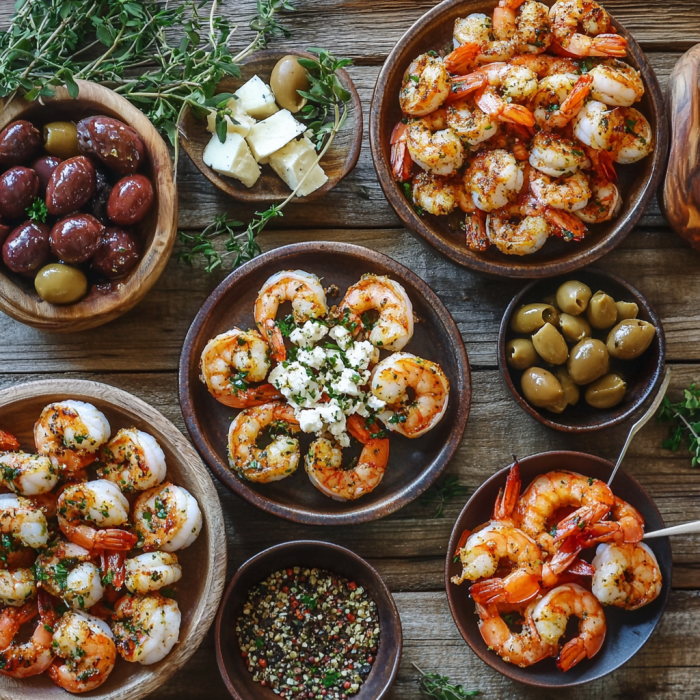
Regional Variations
- New England Style: This classic preparation features a prominent use of Ritz crackers and a delicate balance of seafood flavors. The stuffing is typically moist and buttery, with a hint of lemon and herbs.
- Southern Style: Southern-style baked stuffed shrimp may include spicier seasonings, such as cayenne pepper or hot sauce, for added heat. The stuffing may also be creamier, with the addition of cream cheese or mayonnaise.
- Cajun Style: Incorporate Cajun seasonings, such as paprika, garlic powder, onion powder, and cayenne pepper, for a bold and spicy twist. You can also add chopped andouille sausage to the stuffing for extra flavor and texture.
Dietary Modifications
- Gluten-Free: Use gluten-free crackers or breadcrumbs for the stuffing to make the dish gluten-free. Ensure that all other ingredients are also gluten-free to avoid cross-contamination.
- Low-Carb: Reduce the amount of crackers and increase the proportion of vegetables in the stuffing for a low-carb version. You can also use almond flour or coconut flour as a binder instead of crackers.
- Vegan or Vegetarian: Substitute the seafood with a plant-based alternative, such as hearts of palm or jackfruit, and use vegan butter for the stuffing. This modification creates a vegan or vegetarian dish that still captures the essence of baked stuffed shrimp.
Creative Twists
- International Flavors: Incorporate global ingredients and seasonings to create unique flavor profiles. For example, add curry powder and coconut milk for an Indian-inspired twist, or use soy sauce, ginger, and sesame oil for an Asian-fusion version.
- Cheesy Stuffing: Add grated cheese, such as cheddar, Parmesan, or mozzarella, to the stuffing for a creamy and indulgent twist. The cheese will melt and create a gooey texture that complements the tender shrimp.
- Herb-Crusted: Coat the stuffed shrimp with a mixture of chopped herbs, garlic, and breadcrumbs before baking. This technique creates a crispy and flavorful crust that enhances the dish’s presentation and taste.
Tips for Success with Baked Stuffed Shrimp
Achieving the perfect baked stuffed shrimp requires attention to detail and some insider tips. Follow these guidelines to ensure a successful and impressive result.
Avoid Overcooking
- Monitor Cooking Time: Shrimp can become tough and rubbery if overcooked. Keep a close eye on them and remove from the oven as soon as they turn opaque and slightly pink. Use a meat thermometer to check the internal temperature, which should reach 145°F (63°C).
- Gentle Heat: Preheat your oven to the recommended temperature and avoid cooking the shrimp at too high a heat, which can cause them to dry out or burn.
Prepare Ahead
- Make-Ahead Stuffing: The stuffing can be made ahead of time and refrigerated until ready to use. This saves time on the day of cooking and ensures that the flavors have had time to meld together.
- Assembly: You can also assemble the stuffed shrimp in the baking dish a few hours before cooking. Cover the dish with plastic wrap and refrigerate until ready to bake.
Storage and Reheating
- Leftovers: Store leftovers in an airtight container in the refrigerator for up to 2 days. To reheat, place the shrimp in a baking dish, cover with foil, and bake at 350°F (175°C) for about 10-15 minutes, or until heated through.
- Freezing: You can freeze the shrimp after baking. Thaw overnight in the refrigerator and reheat gently in the oven, covered with foil, to maintain moisture.
Presentation Tips
- Garnishes: Garnish the shrimp with fresh herbs, lemon wedges, or edible flowers for added color and visual appeal. You can also drizzle the shrimp with a sauce or glaze for extra flavor and presentation points.
- Serving Temperature: Serve the shrimp hot and fresh from the oven for the best texture and flavor. If you need to prepare the dish in advance, reheat it gently to avoid drying out the shrimp.
Frequently Asked Questions (FAQs) about Baked Stuffed Shrimp
Baked stuffed shrimp is a popular dish that often raises questions about preparation, ingredients, and variations. Here are some frequently asked questions to help you master the recipe.
-
What is the best size shrimp for stuffing?
- Jumbo or extra-large shrimp are ideal for stuffing as they provide a substantial base for the filling. These sizes are easier to handle and create a more impressive presentation.
-
Can I prepare baked stuffed shrimp ahead of time?
- Yes, you can prepare the stuffing mixture up to a day ahead and store it in the refrigerator. Assemble and bake the shrimp just before serving to ensure the best texture and flavor.
-
What can I use instead of Ritz crackers?
- Alternatives to Ritz crackers include panko breadcrumbs, other buttery crackers, or even crushed potato chips. Each option will provide a slightly different texture and flavor, so choose based on your preference.
-
How do I know when the shrimp are cooked?
- Shrimp are cooked when they turn opaque and slightly pink. Avoid overcooking, as this can lead to a tough and dry texture. Use a meat thermometer to check the internal temperature, which should reach 145°F (63°C).
-
Can I freeze baked stuffed shrimp?
- Yes, you can freeze the shrimp after baking. Thaw overnight in the refrigerator and reheat gently in the oven, covered with foil, to maintain moisture. Freezing is an excellent way to extend the shelf life of leftovers or prepare the dish in advance.
-
What wine pairs well with baked stuffed shrimp?
- A crisp white wine, such as Sauvignon Blanc or Pinot Grigio, pairs well with the rich seafood flavors of baked stuffed shrimp. These wines have a light body and refreshing acidity that complement the dish without overpowering it. For more wine pairing suggestions, you can refer to Wine Folly.
-
How can I make baked stuffed shrimp healthier?
- To make baked stuffed shrimp healthier, reduce the amount of butter and use whole-grain crackers or breadcrumbs for the stuffing. Increase the proportion of vegetables, such as bell peppers, onions, or spinach, to add nutritional value and bulk. You can also use low-fat mayonnaise or Greek yogurt as a binder instead of butter.
-
What is the difference between baked and fried stuffed shrimp?
- Baked stuffed shrimp are healthier and easier to prepare in large batches, as they require less attention during cooking. Fried stuffed shrimp, on the other hand, offer a crispier exterior but are higher in fat and calories due to the deep-frying process. Baking is generally the preferred method for a lighter and more convenient option.
-
Can I use frozen shrimp for this recipe?
- Yes, frozen shrimp can be used in this recipe. Thaw them completely and pat dry before using to remove excess moisture. Using frozen shrimp is a convenient and cost-effective alternative to fresh shrimp, especially when they are not in season.
-
How do I prevent the stuffing from falling out?
- To prevent the stuffing from falling out, ensure the shrimp are properly butterflied and press the stuffing gently but firmly into the pocket. You can also use a small amount of the stuffing mixture as a “glue” to help it adhere to the shrimp. Be careful not to overstuff the shrimp, as this can cause the stuffing to spill out during cooking.
-
Can I make baked stuffed shrimp without crabmeat?
- Yes, you can make baked stuffed shrimp without crabmeat by substituting it with another protein or vegetable. Some alternatives include chopped shrimp, scallops, or finely diced vegetables like bell peppers, onions, or mushrooms. Adjust the seasoning as needed to complement the new ingredients.
Baked stuffed shrimp is a timeless dish that continues to delight seafood lovers with its rich flavors and satisfying texture. Whether you’re serving it for a special occasion or a cozy family dinner, this classic recipe is sure to impress. With the right techniques, ingredients, and presentation tips, you can create a memorable and delicious meal that showcases the best of New England cuisine.
For more delicious seafood recipes, check out our Bisquick Easy Chicken Pot Pie and Creamy Chicken Rice Soup Recipe. For a delightful dessert option, explore our Chocolate Babka recipe or indulge in a Peach Crumble.
